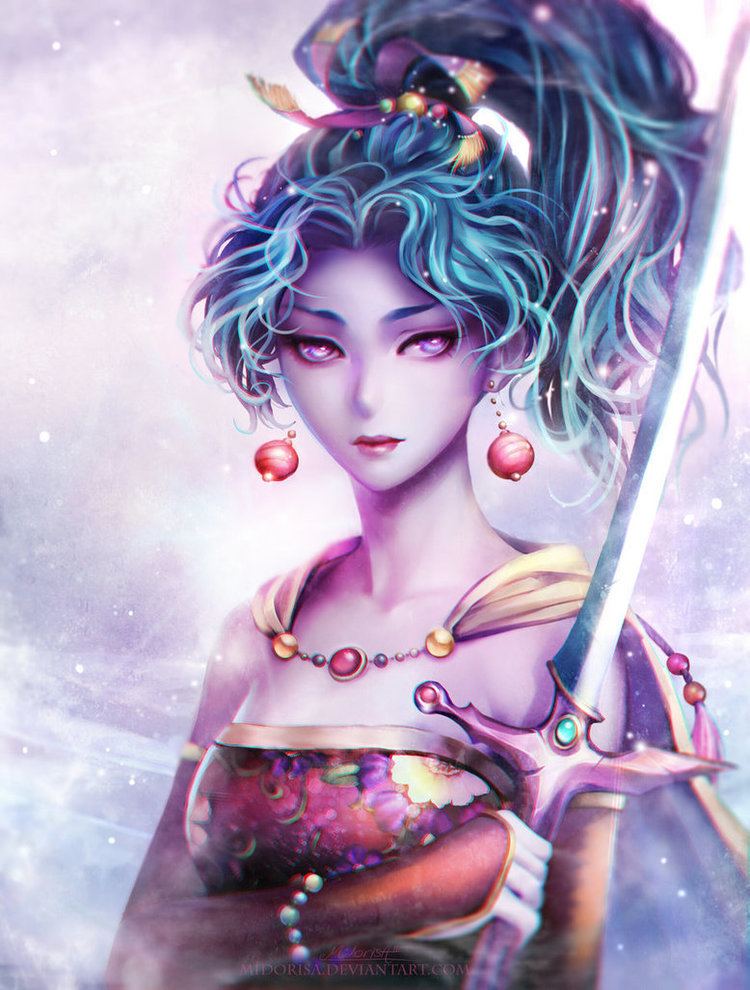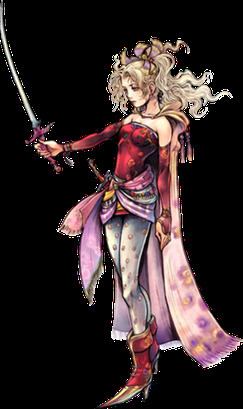 | ||
Designed by Yoshitaka AmanoTetsuya Nomura Voices Yukari Fukui, Natalie Lander Similar Kefka Palazzo, Zidane Tribal, Squall Leonhart, Vaan, Tidus | ||
Terra Branford, known as Tina Branford (ティナ・ブランフォード, Tina Buranfōdo) in Japanese media, is a character in the Final Fantasy series of role-playing video games published by Square Enix. Designed by Yoshitaka Amano and Tetsuya Nomura for the main series installment Final Fantasy VI, she also appeared in the spin-off fighting games Dissidia Final Fantasy and Dissidia 012 Final Fantasy, and made small appearances in several other games in and outside the Final Fantasy series.
Contents
- Dissidia 012 duodecim final fantasy terra branford vs kefka palazzo
- Final Fantasy VI
- Other appearances
- Development
- Reception
- References

In Final Fantasy VI, Terra serves as the main protagonist. She is the daughter of a human and a magic creature known as an "Esper." Mentally enslaved by the antagonistic Gestahlian Empire, which exploits her magic powers for militaristic purposes, she is rescued by rebels at the beginning of the game. The character was very well received by journalists and fans alike.

Dissidia 012 duodecim final fantasy terra branford vs kefka palazzo
Final Fantasy VI

Terra is the first introduced character, a mentally-enslaved Imperial super-soldier gifted with devastating magic. She is tasked to the Magitek-armored assault on Narshe, slaughtering most of the town's militia in pursuit of a recently unearthed frozen Esper. Upon encountering the creature, her Imperial contingent is annihilated together with Terra's armor. She wakes in Arvis' home, freed of her slave crown and suffering amnesia. Pursued into the depths of Narshe's mines by local forces, she is eventually rescued by Locke (a member of the Returners) and a horde of moogles. After experiencing events in the Figaro kingdom and after another Imperial assault on Narshe to claim the Esper, she eventually learns that she is the daughter of an Esper father and human mother, explaining her natural magical abilities. Brain-washed, extensively trained and manipulated, she had been instrumental in the Empire's subjugation of the other city-states on the southern continent, her powers even decimating fifty Imperial troops in moments. Instrumental in the Returner's strategy to ally with the Espers beyond the sealed gate, Terra succeeds in opening the barrier between worlds and unintentionally unleashes the Espers' devastating obliteration of the Empire.
During the World of Ruin, Terra is found bereft of her fighting spirit, having taken on the mantle of a mother figure for the orphans of Mobliz. Ultimately, she fails to stop the attack of a legendary demon known as Humbaba, requiring the party's intervention. Returning later on, the player finds her willing to stand up against Humbaba, joining the player in the fight and avowing to make the world safe for children. At the game's conclusion, expected to fade from existence with the remaining Espers, Terra is informed by the Magicite remnant of her father, Maduin, that so long as some human element of her remains anchored in the world, she will continue to exist.
Other appearances
Terra is the heroine representing Final Fantasy VI in Dissidia: Final Fantasy, crossover fighting game featuring characters from the series, redesigned by Tetsuya Nomura (with both blonde hair in her default appearance and green hair in her alternate appearance). She returns in Dissidia 012: Final Fantasy, appearing as a slaved enemy during the first Dissidia's backstory, and again in the next follow-up game, Dissidia Duodecim Final Fantasy.
Terra also makes a cameo in Secret of Evermore, represents Final Fantasy VI in Theatrhythm Final Fantasy and its sequel Theatrhythm Final Fantasy: Curtain Call, appears as a Legendary character in Final Fantasy Airborne Brigade, appears as one of the random purchasable Premium characters in the shop in Final Fantasy: All the Bravest, is mentioned in Final Fantasy XIII-2, is represented by several cards in Final Fantasy Trading Card Game, and is playable in Final Fantasy Record Keeper. Her outfit appears as in-game avatar parts in Kingdom Hearts Re:coded.
Merchandise items of the character such as a gashapon figurine were produced for Final Fantasy VI. She is featured in the technical demo Final Fantasy VI: The Interactive CG Game.
Development
The character that would become Terra Branford was initially conceived as a half-esper young man in his early 20s. He was a partner and rival of the dark, mysterious Locke Cole. The character's design was eventually changed to that of a half-esper female who is 18 years old in the final version of Final Fantasy VI. Terra was written as a "very passive" character in the first half of the game, in order to show growth as the story progresses. At the end of the game, Terra was supposed to die along with the disappearance of magic, but the development team decided that it would be "going too far" as she had asserted her human side by that point in the story, so the staff decided to have her stay alive, without her magic side.
Terra was originally designed by Yoshitaka Amano, who drew concept art of her. Tetsuya Nomura, one of the game's graphic directors, redesigned her in chibi form for her representation in the game. Some of the differences is that her ingame appearance has green hair, as opposed to the original blonde. In a 2006 interview, Amano stated that Terra was his favorite character to design in the video game industry. The development team intended for the game to have an ensemble cast, with no unique protagonist; however, since the first half of the game revolves heavily around Terra, the team decided to have the second half start with another character, Celes Chere. Another reason for this shift is that the team wanted Terra's story arc to progress in a new direction after the first half.
Although the character's name is "Tina Branford" in Japanese media, American playtesters "hated the name Tina, almost to a person!", according to the game's translator Ted Woolsey. For this reason, and to avoid "disappointment or confusion" in case a player's name in the United States was also Tina, Woolsey renamed the character "Terra" in the North American English version of the game. In retrospect, he acknowledged that some players might also have been named Terra and that some people disliked the name change; however, he noted that the games he worked on "were meant for a broader audience than the one which buys and plays Japanese imports", and that players who know Japanese should play the original versions.
In Dissidia Final Fantasy, Terra was chosen by Nomura as the representative hero for Final Fantasy VI. His reasoning was that without her, there would be no female hero character in the game's roster. He also noted that "based on [his] feelings" from Final Fantasy VI's production, he "thought it had to be Terra", as she appeared on the original game's cover art and advertisement. Gameplaywise, Terra is Nomura's favorite character in Dissidia Final Fantasy.
Reception
The character was very well received, especially among the Japanese fans of Final Fantasy. Even as Tina (Terra outside Japan) does not form a couple with any character in Final Fantasy VI, "Tina and Edgar" and "Tina and Locke" were voted as the fourth and seventh "best couple" in the Final Fantasy series, respectively, in a popularity poll published by V Jump in 1995; that same year, she was also ranked sixth in a V Jump's poll for the most popular characters in the series. In a 2013 poll by Square Enix, Tina was voted the sixth most popular Final Fantasy female character in Japan. In an article about Dissidia Final Fantasy, IGN editor Ryan Clements called her one of the most recognizable and well-loved characters to join the army of Cosmos.
In 1996, Next Generation chose the scene of Terra learning to love again by taking care of a village of orphaned children as the most memorable moment in the entire Final Fantasy series up to that point, stating "it's safe to say that no other game series has tackled such big issues, or reached such a level of emotional complexity. It truly is beautiful." In 2013, Gus Turner of Complex ranked Terra as the fifth greatest Final Fantasy character of all time, calling her "a benchmark for all female protagonists in the series, made unique by the multi-dimensional aspects of her personality and backstory," and stating "what characters like Yuna and Aeris continued, Terra started." Also in 2013, Michael Rougeau of Complex ranked her as the ninth greatest female lead character in video game history, calling her "one of the most compelling and complex heroines in gaming" and declaring her a much better female Final Fantasy protagonist than Final Fantasy XIII's Lightning. That same year, Tom's Guide's Marshall Honorof also included her among top ten female protagonists in video game history. Entertainment Weekly's Darren Franich listed her as one of "15 Kick-Ass Women in Videogames", asserting that "Going through a Django-like transformation from brainwashed slave to active hero, she's far more interesting than the simple Madonna-whore dichotomy of Final Fantasy VII's Aeris and Tifa."
